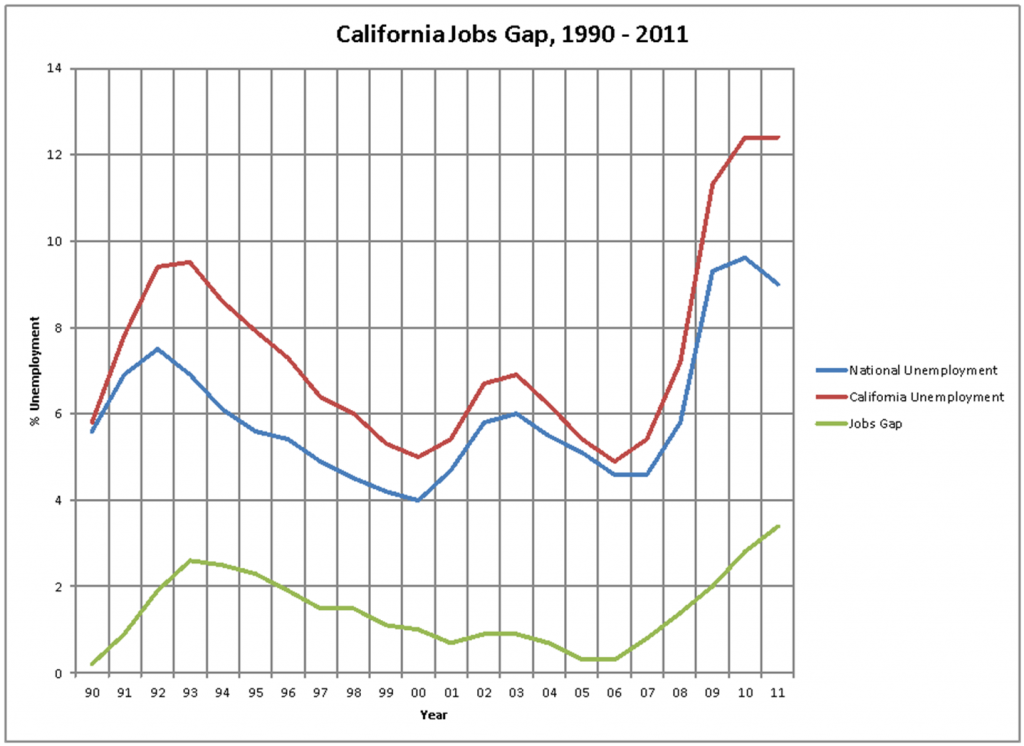CA 'Jobs Gap' Spikes Upward
MARCH 11, 2011
BY JOHN SEILER
New unemployment figures released March 10 show that California’s Jobs Gap has jumped to 3.4 percent in January 2011. That’s up from 2.6 percent a year earlier, in January 2010.
The “Jobs Gap” is a figure I devised a year ago to explain how much California is lagging the nation in unemployment. It subtracts the national rate of unemployment from the California rate. It thus compares us to the rest of the states.
This chart shows the Jobs Gap in dramatic fashion. The “Jobs Gap” is shown by the green line at the bottom. Notice the “hockey puck” shape of the green line, rising sharply upward beginning in 2006. (The number for 2011 is only for January.)
Last December 2010, California’s unemployment rate dropped a little, to 12.4 from 12.5 percent in November. The January 2011 number, also 12.4 percent, represented no change. Moreover, the average for 2011 was 12.4 percent.
Basically, California’s unemployment rate, now second-worst in the country behind Nevada’s, has remained stagnant even as the U.S. unemployment rate has dropped almost a full percentage point. The national economic recovery, though modest, is almost completely bypassing California.
Budget Impact
This should have implications in budget negotiations in Sacramento, especially concerning whether to put Gov. Jerry Brown’s proposed $12 billion tax yearly increase, for five years, on a special June ballot. The focus of the debate so far has been on whether the state can afford the tax increase.
But with these new Jobs Gap numbers, the focus should shift to whether the state can sustain having sucked from its economy $55 billion (the five-year total) at a time when the unemployment lines barely are shrinking.
By contrast, long-depressed Michigan saw its unemployment rate drop a full point in January 2011. And it dropped a hefty 3.0 percentage points from a year earlier. The Great Lake State now is headed by a dynamic new governor, Rick Snyder, who is working for tax cuts and reform.
Gov. Brown seems stuck in Gov. Arnold Schwarzenegger’s 2009 paradigm of meeting a budget shortfall with tax increases. Indeed, Brown even calls his tax increases “extensions” of Schwarzenegger’s. Yet Schwarzenegger’s tax increases didn’t solve the state’s budget deficit problem — or we wouldn’t be stuck with the same problem today.
Arnold may be gone from office. But unlike Elvis, Arnold hasn’t left the building.
Jobs Creation Lags
“We have underperformed on jobs creation,” Esmael Adibi told me; he’s director of the A. Gary Anderson Center for Economic Research and Anderson Chair of Economic Analysis at Chapman University. “We’re not getting any oomph in the construction and mortgage industries” because of the housing crash. “We lost jobs fast. Now, coming out of recession, jobs creation is slow.”
In addition to construction and mortgages, the third industry that’s not creating jobs is state and local government, which have seen their budgets cut. “Usually in the past government jobs were recession-proof,” he said. “Now, nobody is hiring and we’re seeing some layoffs.”
He said he expects unemployment to “remain in the double-digits the next couple of years” in California. “A big unknown is gas prices.” As I noted in a blog today, gas prices are expected to gouge an additional $700 yearly from family budgets.
Adibi said that higher gas prices would “take a bite out of people’s disposable incomes.”
Gov. Arnold Schwarzenegger’s 2009 tax increases are scheduled to expire in July. (The income tax increase already expired in January.) Gov. Brown, as noted, wants to extend them.
“Let them expire,” Adibi urged. “Doing so would boost the economy. Clearly that would be good news for the economy. Consumers would spend that money” that would not be taxed from them.
The uncertainty over what tax rates will be the next couple of years also “is really bad,” he added. “There’s also the uncertainty over gas prices. And consumer confidence is down.”
Bill Watkins agreed. He’s executive director of California Lutheran University’s Center for Economic Research and Forecasting (CERF). “Jobs gains in California are going to lag the nation by quite a bit — for many quarters,” he told me. “There’s a structural problem that are going to cause us to have a slower recovery than the U.S. It’ll be less than it could be.”
He also criticized UCLA’s latest forecast for California, out yesterday, which said jobs were not fleeing from California to Texas; and that high taxes here weren’t forcing businesses to the Lone Star State. UCLA said, in the Los Angeles Times’ summary: “California, for instance, takes about 4.7% of what a business produces in taxes — which happens to be the national average. Texas takes more, 4.9%, according to a study last fall by the Council on State Taxation, a business-friendly trade group.”
Watkins said the UCLA forecast made a mistake in not taking into account “fundamental economics, which says that marginal tax rates count. They’re relatively higher in California.” For example, Texas has no state income tax, compared to a 10.55 percent top California income tax rate.
Also, Jerry Nickelsberg, UCLA senior economist, cited a study by the Public Policy Institute of California purporting to show that California’s high taxes don’t affect whether or not jobs stay or leave California for Texas. I critiqued PPIC’s study in a policy report last August right here on CalWatchDog.com.
Watkins said he uses the acronym DURT — Delay, Uncertainty, Regulations and Taxes — to judge an economy’s potential for economic growth. “The high cost of DURT in California is chasing businesses to Texas,” he said.
Texas’ unemployment in January 2011 was 8.3 percent; that’s 0.7 percentage points below the national rate of 9.0 percent. And it was a hefty 4.1 percentage points better than California’s rate.
AB 32 Jobs Crash
I think we’re also seeing what I’ll now name the “AB 32 Jobs Crash.” Look again at the chart, above. The “hockey puck” turn for the worse in the green line began in 2006, when Schwarzenegger signed into law AB 32, the Global Warming Solutions Act of 2006.
Before 2006, the Jobs Gap was only a little above the national number — close enough for statistical error. But now the 3.4 jobs gap is so large it can’t be ignored. The last five years of the Schwarzenegger administration turned out to be a long offensive against California jobs.
Critics of AB 32 warned that it would kill up to 1 million California jobs over the next decade.
Looks like we’re going to reach that dubious goal ahead of schedule.
John Seiler is CalWatchDog.com’s managing editor: [email protected].
Related Articles
Bernie Sanders goes for broke leading up to CA primary
With California the final battleground in his insurgent campaign to beat Hillary Clinton for the Democrats’ nomination for president, Sen. Bernie
Video: Jerry Brown’s biggest challenge in CA
Chapman University Law School Dean Tom Campbell explains to CalWatchdog.com’s editor-in-chief Brian Calle how he believes the biggest challenge Gov.
Suit filed over shooting of mentally ill man by L.A. County Sheriff’s deputies
Los Angeles County Sheriff’s deputies are accused of shooting a mentally ill teenager in the street in a lawsuit filed





